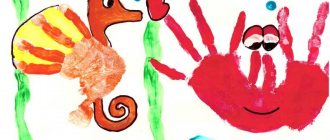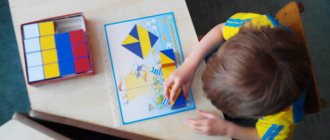Benefits of classes
Drawing in an unconventional palm technique will allow the child to develop the muscles of his hands, and parents will be able to establish psychological contact with the baby. Such activities not only entertain, but also bring benefits:
- develop motor skills;
- give new knowledge about the shapes of objects;
- teach color recognition;
- develop taste.
Regular finger painting classes allow you to strengthen your hand muscles and develop motor skills, and this has a beneficial effect on speech and abstract thinking. The child will be able to learn about new objects by depicting them, and will also become familiar with geometric shapes, different colors and shades. Such home lessons will help parents prepare their child for the first grade of school.
Small objects help develop coordination of movements. Children will be able to expand their horizons and gain new tactile and visual sensations. The child will receive many pleasant emotions from creative activities, he will develop a taste and a craving for beauty. Children express their experiences through colors. Each drawing reflects the joys and fears of a child. Parents should pay attention to what exactly he depicts.
You can start classes from 10-11 months, but the baby should draw only with the help of his parents. It is better to make the first lessons short - 5-10 minutes. Over time, they can be extended to 20-30 minutes.
You should not force your child to draw; it is better to observe his mood. Creativity requires a good mood and inspiration.
Advantages of the palm painting process
The baby's hand muscles develop during the process of drawing.
- The child begins to distinguish colors.
- The baby's creative abilities appear.
- Motor skills develop.
- The baby begins to distinguish different shapes.
- By learning something new, the baby prepares for school.
- Children's horizons are expanding.
Materials and tools
All materials can be found in any store that sells office supplies. Children do not need professional expensive paints. It is better to choose those with a safe composition, because the child can taste them.
Required tools and materials:
- paper;
- finger or any other paints;
- dry and wet wipes;
- cotton swabs and disks;
- old toothbrushes;
- oilcloth or mat for creativity.
You can choose any paper for drawing - A4 or A3 sheets, Whatman paper, coloring books, colored cardboard. You don’t have to buy expensive goods; just buy a standard album or sketchbook. But the paper in them should be thick so as not to get wet from water. Suitable paints include watercolor, gouache, and special materials for fingers. They can be purchased at any art stores. The colors should be bright; there are watercolors and gouache with glitter. Such materials will interest children. You can draw figures not only with your hands - the child can use cotton pads or sticks, toothbrushes.
It is advisable to seat the baby at a comfortable table, and lay a blanket or pillow on the chair to make him comfortable. It is better to cover the workplace with oilcloth or a special rug. In any case, the children will cover it with paints. It is also recommended to dress the child in old clothes that you don’t mind getting dirty. And to cleanse the skin you need to use dry or wet wipes.
Kids won't be able to draw serious pictures yet.
Their first attempts will resemble meaningless scribbles: dashes, sticks, crooked lines, blots. But the more often the child practices, the more interesting his images will become. With age, technique will improve, and the most talented children will begin to create real masterpieces.
Finger drawing animals
An exciting activity for a baby from one year old is drawing animals. True, the smaller the baby, the more imagination parents need to show.
So, a few words about animal drawing techniques:
- fingerprints in random order vertically, horizontally, at an angle. And the parent finishes drawing the paws, tails, faces with pencils or felt-tip pens
- Filling out the finished animal diagram with fingerprints or painting. Options drawn by you, printed on a printer, or offered in special books for drawing with children are suitable.
- stickers with subsequent coloring
- ready-made stamps in the shape of animals. They can be made, for example, from cardboard, linoleum
Below are some examples of drawings:
Precautionary measures
Small children get tired quickly; for the first time it is enough to practice for no more than 5 minutes . Further, the child’s attention will not concentrate on creativity. The first few lessons are an adaptation period. You should not set difficult-to-achieve goals while you need to conduct lessons in the form of a game. While drawing, children, with the help of their parents, will be able to study geometric shapes, names of colors, various animals and types of transport, even body parts.
It is important to properly prepare the workplace and monitor the baby. First you need to deal with the paints. If it is watercolor, then it is diluted with water to a paste-like state. Thick gouache should also be made more liquid. Finger paints are ready to use. You can add glitter to them to make drawing more interesting.
It is better to pour the material into a flat saucer or plate. It is difficult for kids to get paint out of a small jar with their fingers; it is much easier to scoop it out of a large bowl. It is recommended to place a bowl of warm, clean water nearby. The child will wash his hands in it in order to continue using a different color. You also need to place a towel nearby, which can be stained with paint.
It is not advisable to leave your baby alone during classes. A small child can be so inventive that he will paint more than just paper . The role of parents during creativity is to channel the children's energy. The mother or father must communicate with the baby, prompt or help him. But you need to be allowed to make mistakes. Let a child draw crookedly or ugly - this is how he still expresses his “I”.
If the baby is not yet a year old, then it is better to provide him with a floor instead of a table. It is advisable to remove the carpet from it and lay down oilcloth. It is also recommended to remove all items that a child could damage. Wardrobes and beds can also be covered with oilcloth, otherwise they may be painted. If parents are afraid that the baby will freeze, you can put a warm blanket under him.
Drawing a mimosa with your fingers
The task will be interesting for children under 3 years old.
Prepare:
- blank drawing
- yellow paint
- glass of water
- a rag or napkins
You can draw a vase, twigs and mimosa leaves yourself or print a blank from the Internet.
- First, tell and show your child what you expect to see at the end of his work. Come up with a story about mimosa, when it blooms, what holiday it is given to your mother for
- Invite your child to draw flowers with his fingers, including those that have not yet bloomed. Help him play with shades of yellow paint for this purpose.
- At the end of the work, praise the child for his efforts. Save the drawing in an album or hang it on the wall in a frame.
Paint Recipes
The technology called “Finger Painting” involves the use of paints. But many parents worry that they may be dangerous for the child. After all, many kids taste them, and they contain many harmful chemicals.
Some mothers prepare their own paints. The ingredients are quite simple:
- 2 tbsp. flour;
- 1.5 tbsp. water;
- 7 tbsp. l. salt;
- 1.5 tbsp. l. vegetable oil;
- glycerol;
- food colorings.
First you need to mix the dry products - flour and salt. Add water to them and stir until thick sour cream forms. Then add vegetable oil. The ingredients can be mixed with a whisk, fork, mixer or blender. Glycerin is added as desired, it gives the paint shine.
The finished mass is poured into different jars; you can use empty containers from gouache or baby puree. Then you need to add dyes. They can be natural - juice of carrots, beets, celery, turmeric. You can also use food colorings that are added to baked goods.
At home, you can prepare three-dimensional paints for finger painting. You will need few ingredients:
- 1 tbsp. flour;
- 1 tbsp. salt;
- 2 tbsp. water.
The products must be thoroughly mixed and placed in different containers. Then dyes are added to them. For additional shine, glitter or glycerin is added to the mixture. Next, the jars are placed in the microwave for 1.5 minutes at 180 degrees. The result will be a voluminous material. While drawing, the paints will lie on the paper so that any image will acquire a 3D effect.
You can also use porridge for cooking:
- 0.5 tbsp. fine-grained cereals;
- water;
- dyes.
Semolina is suitable for creating paints; it is quite small. It is cooked according to the usual recipe; the consistency of the porridge should resemble sour cream. For greater viscosity, you can add PVA glue to the mixture. The mass is also laid out in small jars and mixed with dyes. This material will also allow you to create three-dimensional drawings. But after applying it to paper, you need to handle the painting more carefully - it must dry. You can fix the cereal with regular hairspray.
Finger drawing toys
- Toys surround the baby from the earliest days. That’s why the desire to draw them settles in the child’s head. It's so fun to depict a helicopter, a car or a bear with a doll walking in the forest or along a green meadow
- You will set the tone and help the baby during a creative flight
- Complete the small details and name the resulting toy. Write a short story about her and her adventures. So your baby will love to draw with you.
Here are some examples of finger painting of different toys:
Tips for parents
Parents should show the little ones exactly how to draw a picture with their fingers. The unusual technique of fine art should interest the child. Use your fingertip to scoop up some paint and make a dot or draw a line on the paper. The baby can repeat this. But you can draw not only with your fingers, but with your entire palm.
Older children enjoy using ready-made templates. You can find them on the Internet and print them or draw them yourself. These are images of fruits, vegetables, animals, transport. They are usually already painted, but have white areas. The child must paint them so that the colors match, or trace the outlines of the drawings .
There are popular pictures that kindergarten teachers use. The finger painting technique is also suitable for depicting natural phenomena. A child can draw the sun, rain, snowfall, and starry night with his hands.
The background is painted over with your fingers, evenly distributing the material over the paper. But you can use colored cardboard. Large images - sun rays, clouds, fish, flowers - are drawn with palms. And small details can be depicted with little fingers, cotton swabs and even toothpicks.
Finger painting will allow you to prepare greeting cards and themed posters for kindergarten. The child will be able to take part in decorating the house for any holiday. And parents will help kids master more complex painting techniques with each new lesson.
Finger painting 3-4 years old
- Children after their third birthday are interested in more complex plot drawings. Their hands are good at drawing geometric shapes and lines
- Children are happy to come up with stories behind their drawings and tell them to their parent or the adult they are working with.
- But they still need your help. You participate in the creative process as a co-author of the drawing, an active listener, an inspiration for the creation of new details on the sheet
Prepare in advance for a drawing lesson with your child:
- come up with a backstory
- take pencils, markers, brushes, crayons, a paraffin candle to add and diversify the future picture
- stock up on napkins, stencils, stamps
- choose your favorite character or doll and conduct an activity on his/her behalf
Drawing techniques that can be used with a child under 4 years old:
- painting a free area
- impressions of palms, stamps, stencils, fingers, fists
- blots, smearing droplets of paint with fingers, blowing them with tubes
- smudge, or pressing down drops of paint with paper or transparent film
- applying paint over a drawing with paraffin
Even if, instead of the script you drew up, a drawing lesson with your child ended in spilled paint and stains on clothes, turn everything into a game. This way, your baby will continue to have the desire to continue drawing and your mood will remain good.
How to draw an apple tree?
Master class on drawing with preschoolers.
Work process:
1. Prepare the materials needed for work
2. First, dip your finger in yellow paint and put dots on the sheet - this will be the sun
3. Next, draw a cloud by dipping your finger in blue paint
4. Then we take green paint for the grass and you can also draw a flower, also dotted
5. Then take a brush and pick up paint for the wood
6. Paint your palm with paint
7. Apply it to a sheet of paper, and then carefully raise your hand, holding the sheet
8. Use one of your painted fingers to finish drawing the trunk
9. Draw red apples and green leaves on the tree
10. We get an apple tree
We train our fingers, trace, draw, write
- This is the title of Alesya Zhukova’s book, which has been mastered and recommended by many parents of preschool and early school-aged children.
- Thanks to a moderate number of tasks, your child will learn to draw geometric shapes, write letters and numbers, count, and evaluate himself by the number of mistakes.
- Your help is still relevant. The tasks are different and may cause difficulties when you first get acquainted with them
The child will master:
- neat drawing technique
- correct and comfortable holding of a pen, pencil, brush
- alphabet and counting
You can purchase the book or find it in the public domain and print it before each lesson.
- Remember, you shouldn’t overload your child; if you notice fatigue on his paper, switch your attention to other activities, go for a walk or give his hands and eyes a rest
- So, we looked at the importance and relevance of regular finger painting classes for kids
- However, dear parents, focus more on the joy and pleasure of joint creativity with your child, rather than on results and achievements
Let your mutual understanding and healthy affection grow stronger every day!
How to draw a fire
A fire is very easy to draw. Below you need to paint two thick stripes with brown paints. They will represent logs. And draw a palm on top with yellow or orange paint. This is how easy and simple it is to create a fire.
- You need to dip your hand into pink or red paint, fingers down. Then dots are painted with black and white paints. Leaves are painted with green paint.
- Four marks from the baby's palms are drawn with fingers down. A circle is drawn on top of the very first palm, which will represent a face.
- If you dip your baby’s palm in yellow paint, this is how you paint mermaid hair. And with the help of a palm with green or blue paint they depict a tail.
- Using gray color you can very easily depict a dolphin. All that remains is to paint the sea in blue.
- You can very easily draw a zebra from one white handprint of a baby. All that remains is to finish drawing the tail. And you will also need black stripes on the white palm mark.









